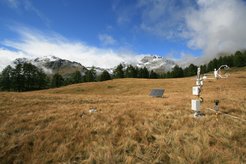Functioning of terrestrial ecosystems is governed by three main factors
Ecosystems provide multiple services for humans. However, these services depend on basic ecosystem functions which are shaped by natural conditions like climate and species composition, and human interventions. A large international research team, led by the Max Planck Institute for Biogeochemistry, Jena, identified three key indicators that together summarize the integrative function of terrestrial ecosystems. The first is the capacity to maximize primary productivity, the second is the efficiency of using water, and the third is the efficiency of using carbon. The monitoring of these key indicators will allow a description of ecosystem function that shapes the ability to adapt, survive and thrive in response to climatic and environmental changes.

Ecosystems on Earth’s land surface support multiple functions and services that are critical for society, like biomass production, vegetation’s efficiency of using sun-light and water, water retention and climate regulation, and ultimately food security. Climate and environmental changes as well as anthropogenic impacts are continuously threatening the provision of these functions. To understand how terrestrial ecosystems will respond to this threat, it is crucial to know which functions are essential to obtain a good representation of the ecosystems’ overall well-being and functioning. This is particularly difficult since ecosystems are rather complex in terms of their structure and their responses to environmental changes.
A large international network of researchers, led by Dr. Mirco Migliavacca at the Max Planck Institute for Biogeochemistry in Jena, Germany, tackled this question by combining multiple data streams and methods. The scientists used environmental data from global networks of ecosystem stations, combined with satellite observations, mathematical models, and statistical and causal discovery methods. The result is strikingly simple: “We were able to identify three key indicators that allow us to summarise how ecosystems function: the maximum realized productivity, the efficiency of using water, and the efficiency of using carbon” says Dr. Migliavacca, first author of the recent publication in Nature. The maximum productivity indicator reflects the capacity of the given ecosystem to uptake CO2. The water use indicator is a combination of metrics representing the ecosystem water use efficiency, which is the carbon taken up per water transpired by plants. The carbon use efficiency indicator reflects the use of carbon by an ecosystem, which represents the carbon respired versus carbon taken up. The surprising findings made the team reflect on how complex ecosystems are ultimately driven by a small set of major factors just like was found, for instance, for leaf photosynthesis based on a handful of leaf traits.
“Using only these three major factors, we can explain almost 72 percent of the variability within ecosystem functions,” Migliavacca adds. “With water-use efficiency being the second major factor, our results emphasize the importance of water availability for ecosystems’ performance. This will be crucial for climate change impact considerations,” says Professor Markus Reichstein, director of the department Biogeochemical Integration at MPI for Biogeochemistry and co-author.
The researchers inspected the exchange rates of carbon dioxide, water vapour, and energy at 203 monitoring stations around the world that belong to the FLUXNET network, a collaborative network of multiple research teams and field sites that collect and share their data. The selected sites cover a large variety of climate zones and vegetation types. For each site they calculated a set of the ecosystems’ functional properties, and further included calculations on average climate and soil water availability variables as well as vegetation characteristics and satellite data on vegetation biomass.
The three identified functional indicators critically depend on the structure of vegetation, that is vegetation greenness, nitrogen content of leaves, vegetation height, and biomass. This result underlines the importance of ecosystem structure, which can be shaped by disturbances and forest management in controlling ecosystem functions. At the same time, the water and carbon use efficiency also critically depend on climate and partly on aridity, which points at the critical role of climate change for future ecosystem functioning. “Our exploratory analysis serves as a crucial step towards developing indicators for ecosystem functioning and ecosystem health,” summarizes Professor Markus Reichstein, “adding to a comprehensive assessment of the world’s ecosystems response to climate and environmental changes.”
Acknowledgment: This work used eddy covariance data acquired and shared by the FLUXNET community, including these networks: AmeriFlux, AfriFlux, AsiaFlux, CarboAfrica, CarboEuropeIP, CarboItaly, CarboMont, ChinaFlux, Fluxnet-Canada, GreenGrass, ICOS, KoFlux, LBA, NECC, OzFlux-TERN, TCOS-Siberia, and USCCC. The FLUXNET eddy covariance data processing and harmonization was carried out by the ICOS Ecosystem Thematic Center, AmeriFlux ManagementProject and Fluxdata project of FLUXNET, with the support of CDIAC, and the OzFlux, ChinaFlux and AsiaFlux offices.












